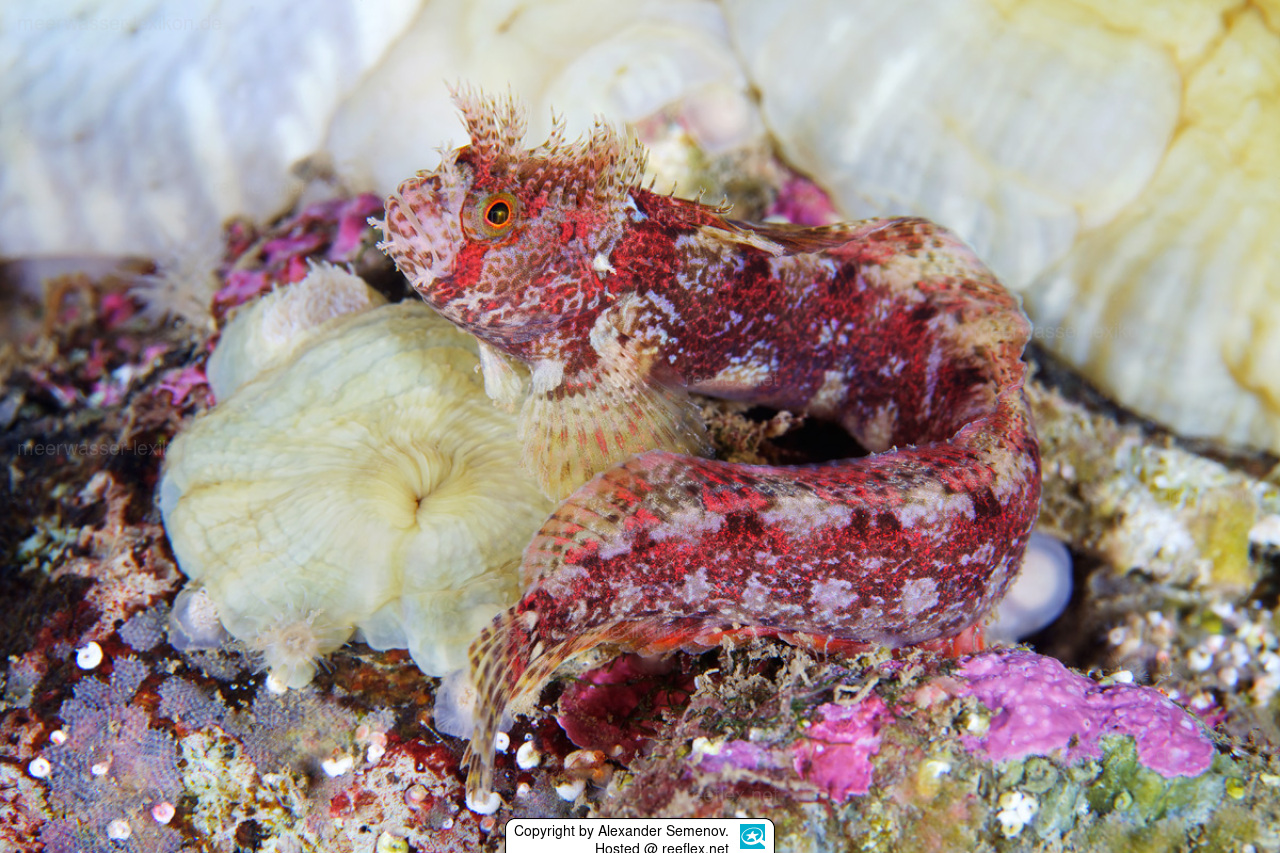Info
The detailed description of Chirolophis saitone in the book "Fishes of the Sea of Japan and the adjacent areas of the Sea of Okhotsk and the Yellow Sea", page 85, shows that this endemic spiny back blenny has a light olive green body colour with chocolate brown spots, and a prominent large eye.
If you now take a look at the photo of Alexander Semerov, this description on the striking reddish-colored blenny, which perfectly blends with a reef stone covered with chalk red algae, is only partially correct!
It is possible that the camera flash influenced the actual coloration.
The initial description was based on a find in Mutsu Bay in Aomori Prefecture in northern Japan.
Another find report from shallow coastal waters comes from Peter-the-Great-Bay in the northeastern Sea of Japan between South Korea and the northern Sea of Okhotsk, which belongs to Russia.
In September 2013, the scientific library "Research Gate" reported a chance find of a specimen in a trawl net from the southern part of the Yellow Sea near Korea.
Neither imports, husbandry reports, nor detailed knowledge of the nutrition or biology of the pretty spiny back blenny are known.
Synonym: Bryostemma saitone (Jordan & Snyder, 1902)
Jumping guard
A jumping guard prevents (nocturnal) fish from jumping out.
Wrasses, blennies, hawkfishs and gobies jump out of an unprotected tank in fright if their night rest is disturbed, unfortunately these jumpers are found dried up in the morning on carpets, glass edges or later behind the tank.
https://www.korallenriff.de/en/article/1925_5_Jump_Protection_Solutions_for_Fish_in_the_Aquarium__5_Net_Covers.html
A small night light also helps, as it provides the fish with a means of orientation in the dark!
If you now take a look at the photo of Alexander Semerov, this description on the striking reddish-colored blenny, which perfectly blends with a reef stone covered with chalk red algae, is only partially correct!
It is possible that the camera flash influenced the actual coloration.
The initial description was based on a find in Mutsu Bay in Aomori Prefecture in northern Japan.
Another find report from shallow coastal waters comes from Peter-the-Great-Bay in the northeastern Sea of Japan between South Korea and the northern Sea of Okhotsk, which belongs to Russia.
In September 2013, the scientific library "Research Gate" reported a chance find of a specimen in a trawl net from the southern part of the Yellow Sea near Korea.
Neither imports, husbandry reports, nor detailed knowledge of the nutrition or biology of the pretty spiny back blenny are known.
Synonym: Bryostemma saitone (Jordan & Snyder, 1902)
Jumping guard
A jumping guard prevents (nocturnal) fish from jumping out.
Wrasses, blennies, hawkfishs and gobies jump out of an unprotected tank in fright if their night rest is disturbed, unfortunately these jumpers are found dried up in the morning on carpets, glass edges or later behind the tank.
https://www.korallenriff.de/en/article/1925_5_Jump_Protection_Solutions_for_Fish_in_the_Aquarium__5_Net_Covers.html
A small night light also helps, as it provides the fish with a means of orientation in the dark!







 Alexander Semenov, Russland
Alexander Semenov, Russland





